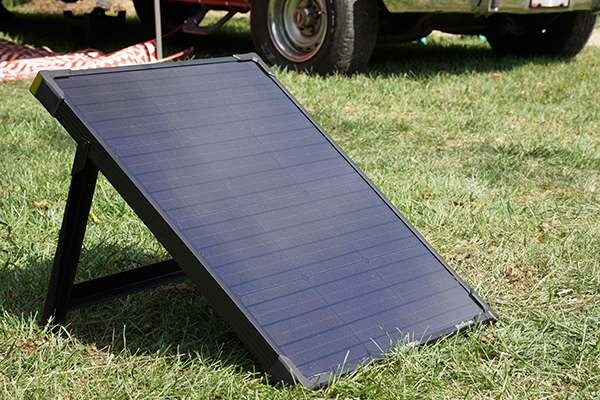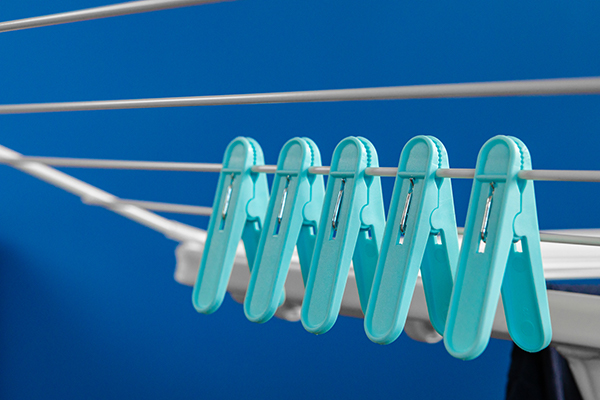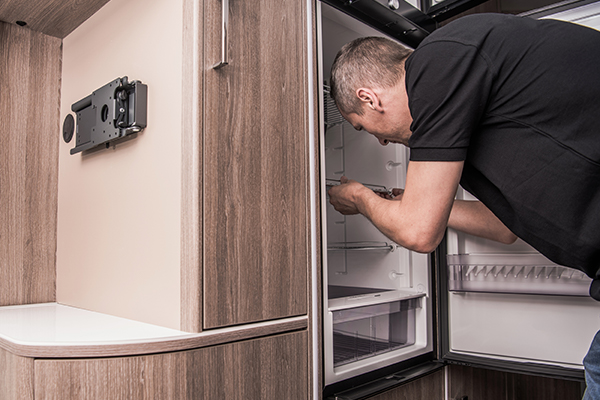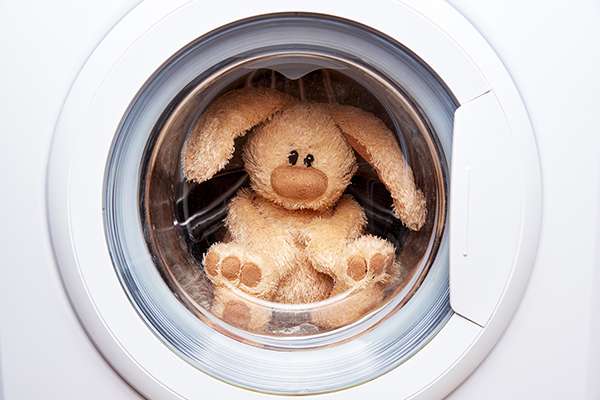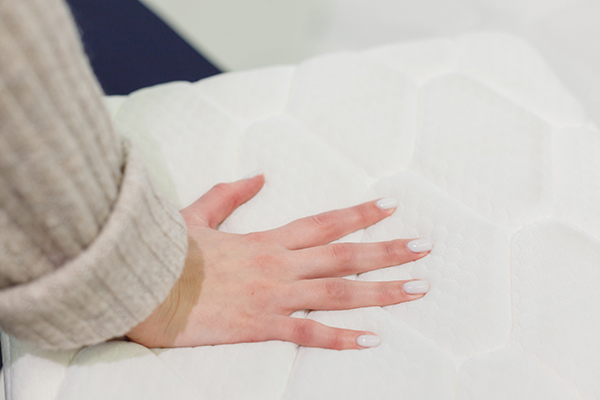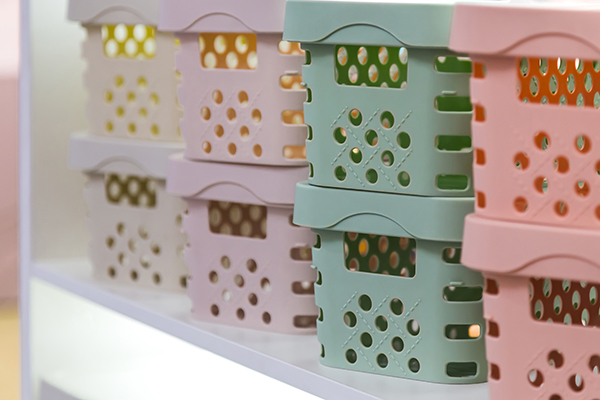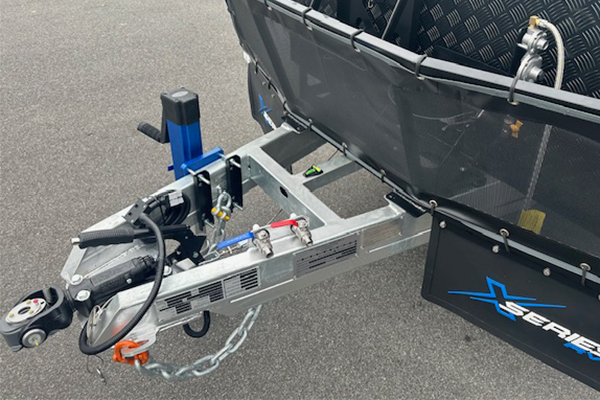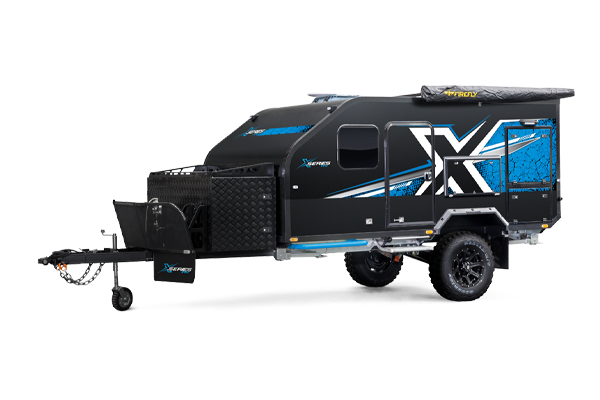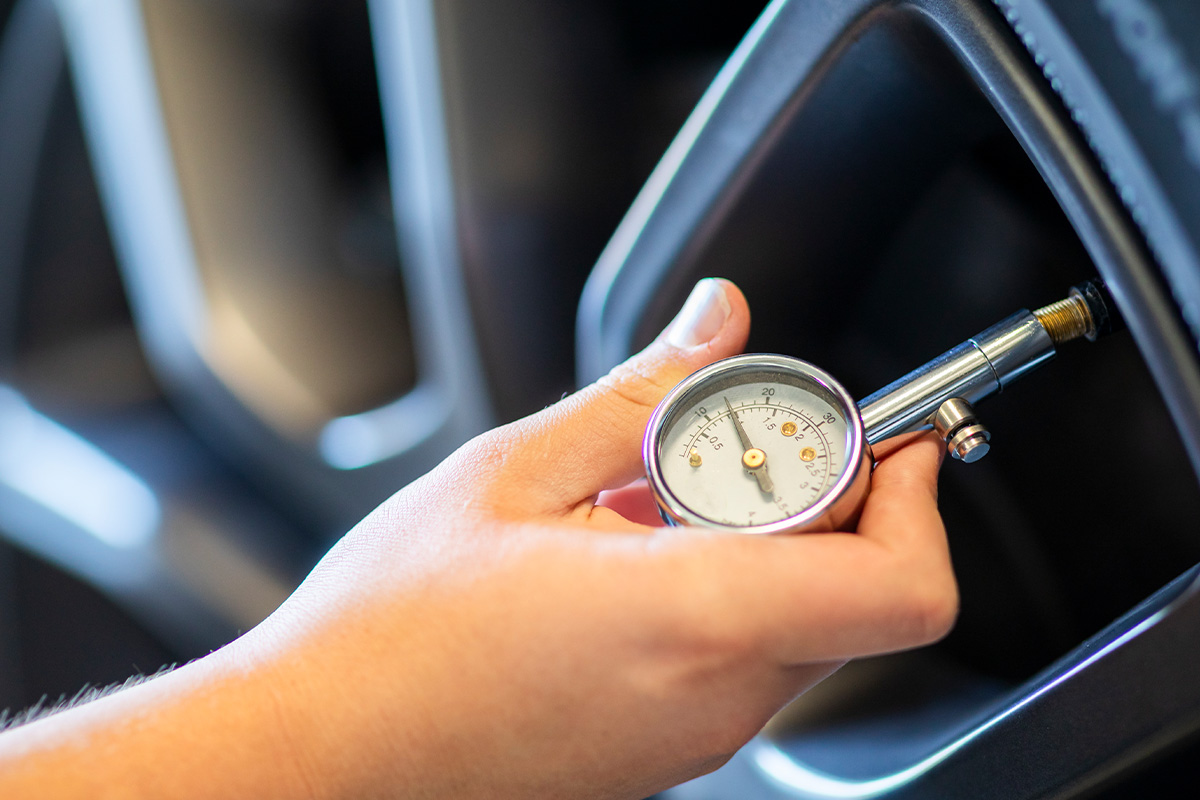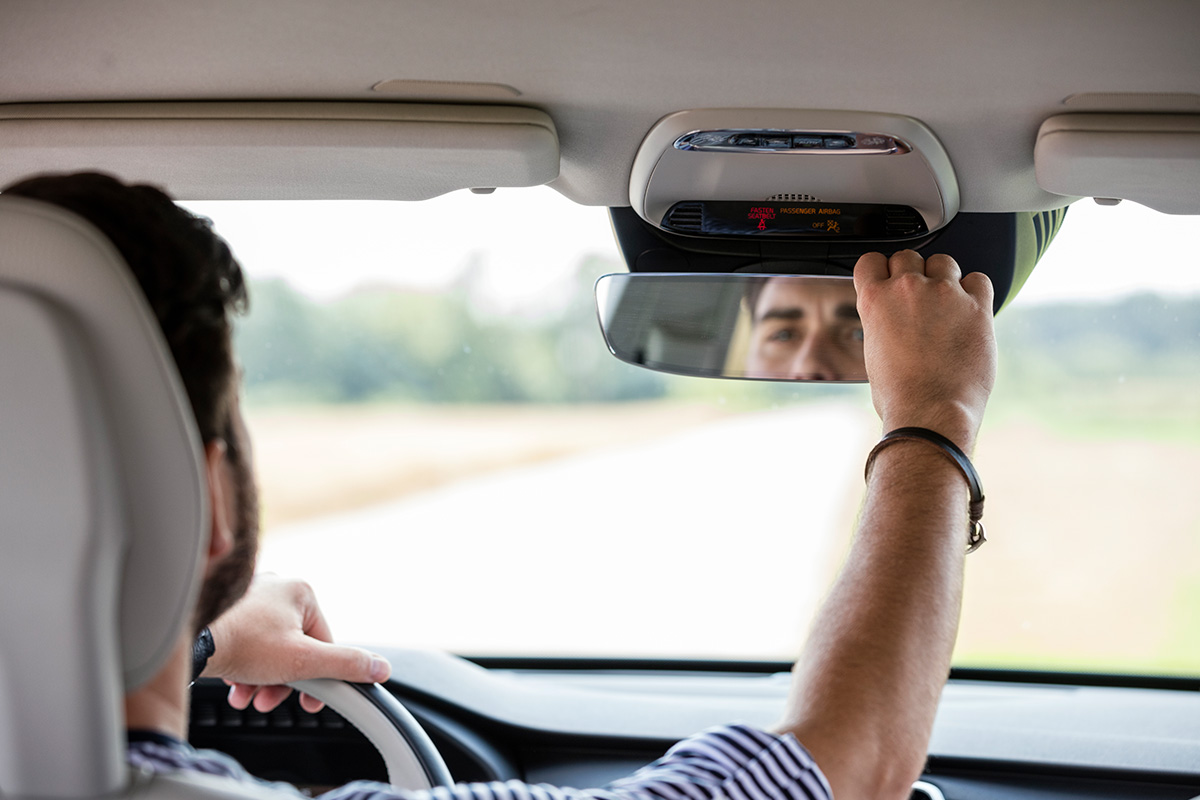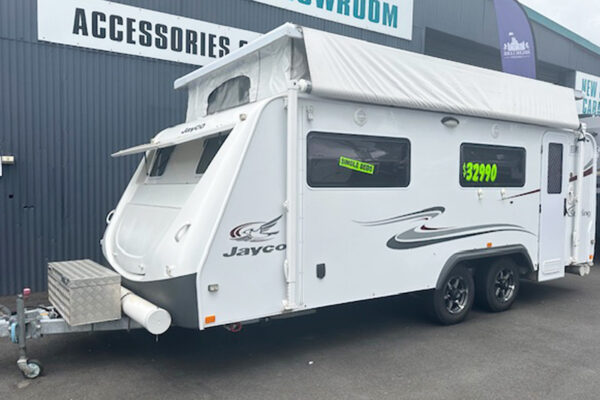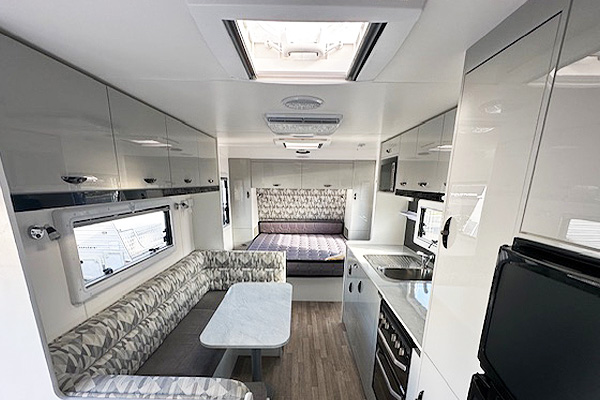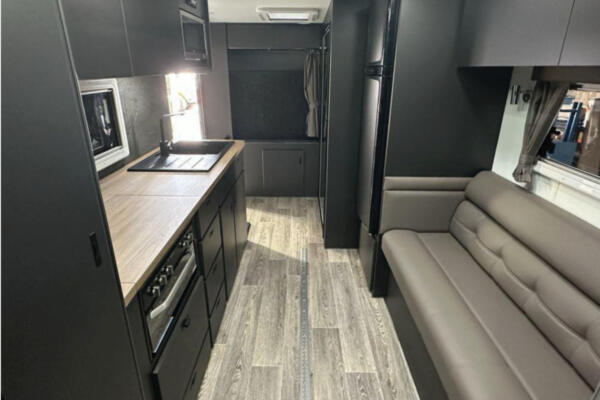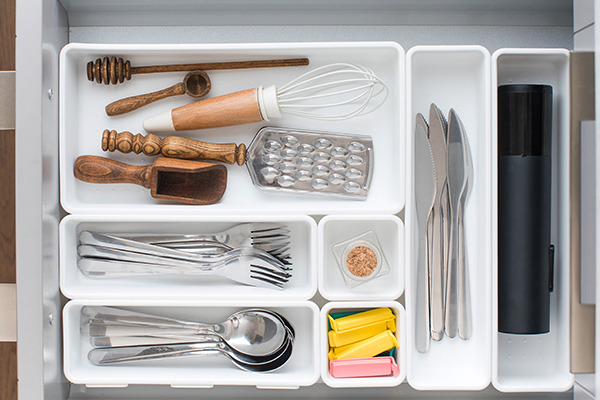Keep up to date with all things caravanning

Most Popular Caravan Accessories
December 13, 2022
With the ever-increasing popularity of caravanning in Australia, there has also come an influx of handy gadgets and accessories. As popular caravan accessories like solar panels and slide-out kitchens continue to hit the market, caravan travel is becoming more convenient.
This article looks at some of the top caravan accessories for the interior and exterior of the caravan. Additionally, we will discuss why these accessories can benefit your current or future caravan setup. We will also look at storage solutions for areas like your caravan tunnel boot, closet, bathroom and kitchen.
Exterior Caravan Accessories
Exterior caravan accessories refer to anything installed on the caravan’s exterior. These accessories are typically useful for extra storage and functionality. Below we explore some popular and commonly requested exterior caravan accessories.
Caravan Reversing Camera
Caravan reversing cameras are extremely useful as a companion to conventional towing mirrors, offering additional safety and visibility for drivers. Reversing cameras are typically used for hitching the caravan to the towing vehicle and reversing a fully-hitched caravan into a caravan park.
It’s typically recommended that caravan enthusiasts invest in a good wired dual camera system. These systems are usually recommended for caravans, as wireless setups often experience interference due to connectivity issues. A wired system forgoes these issues by installing a dependable connection around the vehicle. Additionally, wired systems often come at a lower cost than their wireless counterparts.
Dual camera systems use two cameras to give you a comprehensive view of the area behind your caravan. Both cameras are mounted to the back of the caravan, with one pointing at the rear traffic with a field of view of around 5 metres.
This visibility helps you monitor clearance and the activities of vehicles behind you for extra security on the road. The second camera is pointed at the bumper and allows vision of roughly 3 metres behind the caravan. This camera is primarily used for reversing.
All camera systems are connected to a monitor in the towing vehicle. These monitors can be one of two different types: dash-mounted or clip-on. Dash-mounted monitors are attached to the dashboard of the towing vehicle. Clip-on monitors are attached to the rearview mirror of the towing vehicle. Ultimately the choice between the two comes down to preference.
Caravan Solar Panels
If you’re interested in off-grid caravanning or simply pride yourself on being prepared for any situation, caravan solar panels are a crucial step towards self-sufficiency. Additionally, investing in solar power for your caravan is an excellent step towards clean energy production. A typical solar panel installation consists of 1 to 2 panels, but you can scale up or down to meet your energy needs.
There are two standard options for solar panels: portable and fixed. In terms of accessories, portable solar panels are more common as they allow for flexible usage. Travellers can quickly adjust and move them according to the best location and keep their caravan in the shade. These panels are typically used with fixed panels to keep the caravan batteries charged on overcast days.
Inversely, fixed panels are fixed to one location and typically mounted to the caravan’s roof. These panels are better at resisting bad weather and are less likely to be stolen than portable panels. However, they require the entire caravan to be moved into the sun to charge. Fixed panels are a great addition to your caravan for off-grid travel and can improve the caravan’s resale value.
Tracking Systems for Anti-Theft
Protect your caravan from theft with the use of an anti-theft tracking system. These systems use wireless GPS tracking connected to an Apple or Android phone application to enable you to quickly and efficiently track your caravan in the event of theft. At Canterbury Caravans, we offer two robust anti-theft systems with numerous additional security features.
This discrete tracker can be hidden almost anywhere in your caravan and provides regular updates every 15 seconds. Some key features of this anti-theft system include:
- A security alarm fence around the vehicle
- Alerts for when the speed limit is exceeded
- Log-keeping and servicing reminders
This system performs similarly to the AL-KO with the addition of an automatic braking system, which will immobilise the vehicle if any unauthorised towing is attempted. Additionally, this system includes:
- External light and 105db alarm system
- Intrusion detection for detecting attempted break-ins
Caravan Clothes Line
If you’re aiming for a more eco-friendly setup, invest in a caravan clothesline. Not only are they better for the environment, but for your wallet too, reducing laundromat costs and even increasing the life expectancy and appearance of your clothing.
For a budget option, consider a simple portable foldable clothesline. These clotheslines have pegs that you can use to keep your laundry in place on windy days. They are also very flexible, so you can move your laundry depending on the weather.
These clotheslines offer a lot of hanging space and are easy to set up and pack away. Portable clotheslines also take up a small amount of space.
However, if you want to eliminate storage space usage, consider a caravan-mounted clothesline. These clotheslines are fixed to the exterior wall of your caravan and are even simpler to set up; however, they often offer less hanging space.
Caravan Bike Rack
Bike racks are great for saving on storage space and keeping bikes stored safely and conveniently. There are a few different types of bike racks you might want to consider:
- A-frame – Mounted on the caravan’s A-frame, these racks are typically positioned high to avoid blocking or touching caravan fittings. These racks are not commonly used with caravans that have short drawbars, as they can get in the way.
- Rear wall – A rear wall rack is a great space-saving option for caravans that can support the rack and bikes.
- Roof-mounted – Roof-mounted racks are preferable for transporting pricier bikes as they reduce the risk of scratching or bending your bike.
Slide-out Kitchens
If you prefer a more relaxed day in the sun with good food, you may be interested in a slide-out kitchen. Slide-out kitchens are compact, super functional outdoor kitchens built on telescopic runnings attached to the side of your caravan. These kitchens typically include a complete kitchen setup with burners, a sink, a prep area and additional storage and are built using aluminium and stainless steel materials for their lightweight and corrosion-resistant properties.
Slide-out kitchens come in various sizes depending on the owner’s needs and typically cost around $2,400 to $3,000, depending on the size. Slide-out kitchens aren’t just clever gadgets to show off to friends and family; they also have many benefits, including:
- Keeping cool – Cooking in a caravan can quickly heat up the space and make the area uncomfortable. A slide-out kitchen keeps the smells and heat out of your living space.
- Enjoying nature – Cooking with a slide-out kitchen gives you the opportunity to enjoy the fresh air and beautiful natural scenery around you.
- More living space – Keeping the kitchen stowed away when not in use gives you the opportunity for extra living space.
Starter Packs
At Canterbury Caravans, we offer starter packs with a fantastic bundle of essential accessories. This bundle can be a great starting point if you’re unsure of what you’ll need for your future caravanning trips. Our starter packs include the following:
- Drinking water hose – As its name suggests, a drinking water hose is a must-have accessory for accessing safe drinking water on the go. These hoses are Australian Standard compliant with safe PVC inner linings, abrasion resistance and brass snap-on fittings for a quick and stable water connection.
- Sullage hose – These hoses connect to the wastewater outlet and drain grey wastewater from sinks and showers. These hoses are typically routed to specially allocated drains to ensure safe disposal and should measure a minimum 32mm diameter.
- Caravan power lead – Typically ranging anywhere from 1.5 metres to 25 metres, these heavy-duty leads are designed to safely connect your caravan to a powered campsite or power socket.
- Hose bag – A designated hose bag can cut out the fuss of storing your hose. These bags are made with rot-proof and durable materials and can store up to 20 metres of hose. A good hose bag will also include appropriate drainage for any water runoff from your hose.
- Electrical lead bag – Electrical leads can also be difficult to store, so having a designated bag will reduce the chance of your leads tangling together. Additionally, these bags are made of breathable material to reduce the chance of mould build-up.
- Caravan T-level – Also known as a two-way spirit level, a t-level is used to check that your caravan is level both horizontally and vertically. This is an essential tool for safe towing, as an unlevel caravan can increase the risk of sway and tire wear.
- Dual levelling ramp set – Last but not least in our starter pack is the dual levelling ramp set. These heavy-duty ramps are used to level caravans parked on uneven ground and prevent issues such as incorrect water drainage, 3-way fridge failure and shifting items or rolling items.
If you’re interested in one of our starter kits, get in touch with us today to learn more.
Toolboxes
In addition to storage bags, toolboxes of varying sizes can be a great way to store things such as generators, annex poles and gas bottles. Not to be mistaken for small household toolboxes, a caravan toolbox is a large metal box attached to the exterior of your caravan. There are many types of tool boxes that can be installed on a caravan, including drawbar, rear bar and underbody storage boxes. Each is stored where its name suggests and is made of heavy-duty aluminium. These boxes can also have multiple lid configurations, including top lids, side doors and slides.
Grey Water Tank
A grey water tank is an absolute necessity for free camping and self-sufficiency. Grey water tanks store all wastewater your caravan creates that isn’t from the toilet. This can include water from your sinks, shower, etc. These thick-walled tanks can typically hold anywhere from 60 to 150 litres of wastewater. Storing your grey water in the tank reduces the impact your caravan has on the environment. This is due to the fact that a lot of grey water has contaminants that can be damaging to the environment, such as soap or cleaning products.
Also, old stored grey water can be bad for plants when improperly disposed of. While there is no blanket requirement for grey water storage, some campsites have regulations or restrictions around grey water with specific guidelines on its disposal. By storing your greywater, you can dispose of it at a suitable location, such as a caravan park grey water drain.
When using a grey water tank, it’s important to be mindful not only of where you dispose of your grey water but also of what you put into your tank. Where possible, opt for septic-friendly soaps, washing detergents and biodegradable products. You should also try to reduce any food debris from being washed down the sink drain by scraping your plates and bowls before placing them in the sink.
Stone Guards
Also known as a stone shield, a stone guard is a metal frame with durable mesh attached to the drawbar of a caravan that is used to protect your caravan from rogue stones and debris. This is an essential tool for preventing damage to your caravan, with rocks flung up by the tires of a caravan often causing damage to things such as drainage pipes and gas lines. Additionally, a stone guard can prevent aesthetic damage and help preserve your caravan’s resale value by preventing things such as dents and scratches.
Interior Caravan Accessories
Interior caravan accessories refer to anything installed inside the caravan. These accessories are typically helpful for quality of life and comfort. Read on to learn more about the most popular interior caravan accessories we typically encounter.
Caravan Fridge
No matter how long the journey, if you have the option, a caravan fridge is an absolute must. Access to your own food will save you money on expensive takeout and bland long-last alternatives. Caravan fridges come in two different types:
- 3-way fridges – Also known as absorption fridges, these fridges can operate off of three different fuel sources: 240V, 12V and gas. 3-way fridges are extremely popular for caravanning and camping because they are reliable and efficient. For example, a good 3-way fridge can last a couple of weeks on a 9kg bottle of gas. However, these fridges are typically difficult to install and more power-hungry when running on a 12V connection. Some manufacturers combat this by using an AES (Automatic Energy Selection) system that automatically detects and connects to the best energy source available. Finally, 3-way fridges are completely silent due to the absorption method requiring no moving parts.
- 2-way fridges – Also known as compressor fridges, are very similar to regular household fridges. However, they operate at a lower voltage of 12V or 24V. Because these fridges are designed for 12V power supplies, they operate much more efficiently on 12V than a 3-way fridge. Finally, 2-way fridges are much better at keeping a consistently cool temperature, even in hot areas. This is an essential factor to take into account depending on what kind of climate you plan to travel in.
Caravan Washing Machine
Recommended by caravanners everywhere as a must-have accessory, caravan washing machines are sure to make your life easier. In a small space with any number of travelling companions, it’s crucial that you keep on top of housekeeping for everybody’s sake, which can be challenging without reliable access to a washing machine.
Caravan washing machines come in 2 to 4kg models and are typically cold water machines however with a great price tag; you can get hot water models. When purchasing your caravan washing machine, you’ll need to consider a number of factors, such as child-proofing, load capacity, size and more.
Caravan Mattress Topper
Sleep easy in your freshly washed and air-dried bedding with a cosy mattress topper. While there have been leaps and bounds in high-quality caravan mattresses, for those who struggle to get comfortable or experience pain from unsupportive mattresses, a nice mattress topper can help improve comfort.
There are still many different types of mattress toppers to choose from, including:
- Memory foam mattress toppers – One of the most popular materials on the market, memory foam is a fantastic option for those needing extra support. These toppers are also great for couples, as they cushion movement, meaning you won’t wake each other in the middle of the night. These toppers are, however, more liable to retain warmth and may not be suitable for those who prefer a cooler temperature at night.
- Egg crate mattress toppers – These toppers are named for their strong resemblance to an egg crate. They are easily rollable and portable, making them ideal for travel and camping. These toppers are also extremely light and affordable and can be stacked according to your topper needs. Unlike memory foam, the shape of these toppers allows for better airflow and prevents them from getting too hot at night. These toppers are less durable than others because they are thin and lightweight. They also provide less comfort than memory foam options.
- Hollow fibre mattress toppers – Hollow fibre mattress toppers are made from a synthetic material called microfibre. They are not great for support, but they offer anti-allergy options. Additionally, these mattress toppers are typically more affordable and don’t have any particular chemical manufacturing odours. These toppers don’t last very long, but they are a good option if you’re on a budget.
- Latex mattress toppers – These mattress toppers are made from synthetic rubber or rubber tree sap and are extremely durable. They provide the same level of support as a memory foam mattress topper. Additionally, these toppers are typically anti-microbial and anti-allergenic (excluding latex sensitivities or allergies). The downsides are that these toppers are expensive and have a slight odour. They can also be quite warm to sleep on due to their heat absorption qualities.
Ultimately, the best mattress topper will be the one that meets your specific sleeping needs. Be sure to do your research and read reviews to find the perfect topper.
Fitted Caravan Bunk Sheets
Choosing a topper for your caravan mattress isn’t the only important piece of bedding; you will also need a fitted caravan sheet. This is especially important for bunk beds which can be difficult to access when making the bed. Additionally, all mattresses in your caravan will generally be shaped and sized differently from your typical home mattresses, making standard bedding unsuitable (although possible). At Canterbury Caravans, our caravans include an innerspring mattress with an optional pillow top upgrade for the main bed. All of our bunk mattresses are typically high-density foam. If you’re looking for custom-made fitted caravan sheets, we offer custom-made sheets in-store on request.
Lithium Batteries
The most lightweight option presently on the market, lithium-ion batteries have taken the caravanning community by storm. 50% lighter than traditional AGM batteries, lithium-ion batteries offer longer discharge times between recharging, making them a must-have if you plan on spending long amounts of time off-grid camping.
While more expensive than other batteries, lithium-ion batteries have a depth of discharge of almost 80% and weigh half the weight of lead-acid caravan batteries. Additionally, these batteries often offer smartphone companion applications meaning monitoring your usage and battery status can be done at the touch of a button.
Diesel or Gas Heater
Electricity is not the only thing you’ll need on the road. You will also need warmth, provided by either a gas or diesel heater. Despite common misconceptions that it’s all sun and surf in Australia, with many cold nights and days camping, a readily available heater is an absolute must. The most common heater type for caravans in Australia is the diesel heater.
Diesel heaters are popular for many reasons. Not only are these heaters easy to refuel with diesel readily available at service stations and stored in your vehicle’s tank, but they are also highly efficient with an extremely low fuel consumption rate. Additionally, a diesel heater produces dry heat, meaning there’ll be no excessive condensation build-ups in your caravan.
Finally, you can run a diesel heater on the road, meaning you can preheat your caravan before you even arrive at your destination. These heaters are easiest to install in diesel engine vehicles, as gas-powered vehicles will require an additional diesel fuel tank.
The other heater type used for caravans is gas heaters. Gas heaters differ from diesel heaters in that they consume liquid propane from a separate source from the vehicle itself. This can be beneficial in managing your vehicle and heating sources as it’s easy to distinguish and allocate between them.
Gas heaters are also much quieter than diesel and cheaper to install. However, gas heaters are subject to stricter installation requirements due to higher safety standards. Additionally, gas can be difficult to source in Australia due to increased demand.
Caravan Water Filter
Gas or diesel, while these liquids are important for your travel, the most important thing to remember is water! Specifically, drinkable water. While it’s typically quite easy to access clean drinking water in Australia, some areas may only have untreated water from dams, waterways and tanks. Getting a reliable water filter will help you filter out contaminants and nasty flavours such as:
- Chlorine
- Parasites
- Bacteria
- Heavy metals
- Rust
- Sediment
- Chemicals and pesticides
There are two types of filtration processes: activated carbon filtration and reverse osmosis water filtration. Activated carbon filtration is an affordable process that uses compressed carbon blocks or granular activated carbon (GAC) to filter your water.
As compressed carbon blocks can be quite dense for a finer level of filtration, they are typically used for drinking water, while things that demand a stronger water flow (such as showers) will typically use GAC. Carbon filtration systems are much less effective than their reverse osmosis counterparts and are usually used in in-line installations.
Reverse osmosis water filtration is a highly effective but time-inefficient method where water is fed through a membrane. These filters are much more expensive than other options and are typically only suitable for under-sink installations.
Filtration systems are applied either inline or under-sink. This means that inline filters are installed into your water pipeline system, while under-sink are fitted beneath the sink for safe drinking water. Inline filters can even be strategically placed in your water pipeline to reduce sediment buildup within your water tank.
12 Volt Caravan Fan
Stuck in a scorcher with no working air conditioning? Or trying to preserve energy while free camping? A 12-volt caravan fan can be a fantastic and cheap-to-run alternative. Unlike traditional household fans, these fans are perfectly designed for caravan use with features such as:
- Compact and lightweight design – Smaller and more portable fans are crucial for last-minute weight distribution adjustments. Additional appliances can quickly add up in terms of weight and impact your ability to safely tow your caravan.
- Preset timers – Avoid unnecessary energy consumption with preset timers. Never worry about falling asleep with the fan on or draining your battery with excess usage again.
- 360° airflow – Get the most out of your fan with a 360° airflow meaning no more fights over who gets to sit by the fan.
- Long battery life – Take your fan wherever you want with a rechargeable battery. This is especially useful for staggering your usage according to power availability when travelling off the grid.
- Low power consumption – Ensure that you get the most out of your caravan charge with low power consumption preserving as much energy as possible.
Internet
If you’re interested in working while travelling or simply want to keep your kids entertained while on the road, you’ll need to make sure you have reliable internet. Working while travelling will require being able to keep in touch with your clients, coworkers and employers. Even if you’re simply travelling for leisure and don’t intend to work, keeping entertained in poor weather, relaxing or entertaining the kids are all valid reasons for getting a good internet connection set up. There are multiple ways you can stay connected while travelling, including:
- Mobile hotspots – Accessing the internet through a mobile hot-spot is an option; however, 27% of Australia is without phone coverage, meaning this option may not always be possible. You can improve the quality of your phone reception and data with an antenna, but this solution is still not very fast or reliable.
- Portable modem and router – Standalone portable Wi-Fi uses an individual SIM card and data plan to provide high-speed internet. However, this option can be expensive. You might also consider an all-in-one kit with a modem and mounted external panel antenna to improve reception when off the grid. A system like this can be costly; however, it can improve your internet speeds by up to 6 to 7 times a phone/antenna system.
Where you’re unable to access the internet, there are often caravan park WiFi options; however, these can sometimes be unstable or less safe than private options and should only be used where absolutely necessary.
Charging options
Using 12V charging options such as a USB socket will allow you to access your caravan’s 12V system’s battery power. This will enable you to charge various devices, including tablets, phones and Bluetooth speakers. These sockets typically offer single or dual ports and can be installed into either interior or exterior panels. Not only are these USB sockets designed to be highly durable, but they also often include dustproof covers for improved exterior mounting.
Inverters
An inverter is needed if you’d like to use appliances in your caravan, such as TVs, hairdryers, fridges, etc. An inverter is used to convert 12V or 24V direct current (DC) power to 240V alternating current (AC) power and is essential for free camping when the main power is not available.
Inverters come in numerous sizes, anywhere from 150W to 5000W, which should be chosen according to your caravan’s peak energy requirements. This means taking the peak wattage of all 240V appliances in your caravan and adding them to determine the maximum capacity your inverter will need to have. A large inverter will also require a large battery, meaning you will need to ensure that your battery can support the inverter. For example, if you have a 200Ah battery with an average output of 12.5 volts, you will need a 2000-watt inverter (250 x 12.5).
As a reference point, a 400W inverter will be more suited to powering small and efficient devices such as phones and laptops, while something larger such as a 2600W inverted, can be used with devices such as air conditioners. Depending on the size, an inverter can cost anywhere from $50 to $3000. There are two types of inverters that you can purchase:
Portable inverters – Available in sizes between 400W and 2000W; portable inverters are stand-alone units that need to be closely located to the battery to operate. These inverters also require a direct connection to appliances and are typically a viable and cheap solution for those with lower energy consumption.
Built-in inverters – Available in sizes between 2000W and 3000W, a built-in inverter requires professional installation and provides power to numerous sockets throughout your caravan.
An inverter is crucial for free camping and general comfort, so make sure to discuss with your retailer about your energy needs and battery setup to ensure you get the best inverter possible.
Caravan Storage Ideas
Last but not least, the most sought-after accessories all centre around one thing: storage. Travelling by caravan will mean being acutely aware of different items’ space and weight demands, as well as learning where you can afford to travel light. Sharing a space with your kitchen, bathroom, bedroom and living space can quickly get messy, even without travelling companions, so having some hand storage ideas in mind is sure to help. There are some key areas of your caravan you’ll want to be mindful of when considering storage:
- Bathroom/Laundry – With heaps of beauty and hygiene products to account for, stuff can add up quickly in the bathroom. For your bathroom, you’ll want to look for the following:
- High-suction shower caddies and shelves to prevent your stuff from toppling around while on the road.
- Storage racks with adjustable dividers so you can free up space or adjust the shelves to match larger items.
- Tension rods to dry things such as bath mats or towels or even to dry items in private.
- Collapsible laundry hampers for easy storage when not in use.
- Kitchen – Organising your kitchen can be difficult, especially in a small space like a caravan. But with these helpful tools, you can reduce the clutter and make your kitchen more functional. For your kitchen, you’ll want to look for the following:
- Stick-on-hooks to hang and hideaway extra hand towels and dishwashing tools.
- Stackable baskets or boxes for organised collections, e.g. spices, baking, sauces, etc.
- Clear containers so you can quickly identify the contents without pulling everything open.
- A labeller for even easier and faster identification.
- Pot separators or felt protectors for preventing pots and pans from rattling around and scratching against each other.
- A magnetic strip for easily and stylishly holding knives and other utensils.
- Traditional cutlery organisers for keeping your spoons, forks and butter knives separate.
- Nesting bowls and measuring spoons for neat stacking.
- Sink covers can be a great way to utilise the space over the sink when you don’t need it for activities such as meal preparation.
- Bedroom/Wardrobe – Sleep comfortably, knowing you’ve got everything organised and ready to go. For your bedroom, you’ll want to look for:
- Under-bed storage for items, extra bedding and towels.
- Hanging shoe racks in your wardrobe for shoes, underwear and swimmers.
- Slim velvet-covered hangers for more space and fewer fallen clothes.
- Tunnel boot – Keep your boot tidy and organised, so you don’t have to go diving for your stuff with these handy tools. For a tunnel boot, you’ll want to look for:
- Storage boxes, stackable crates and baskets.
- Toolbox or tool bag for all your essential tools.
- Removable containers for frequently used items.
- A slide-out shelf for easy access.
- Separate storage bags or hose holders for hoses.
Remember, while storage solutions can amp up your space, they can also contribute extra weight to your caravan. Additionally, while you may be tempted to fill all the extra freed-up space with more items, this will only increase clutter and your overall towing weight. We discuss the importance of towing weight and more in this informative article here.
Getting out on the road in your caravan can be the beginning of an unforgettable adventure, and with the right planning, you can guarantee you’ll have a comfortable space to travel, entertain and relax in.
The caravanning community is full of kind and friendly people, meaning even if you forget a few bits and bobs, you’re sure to find someone happy to lend a hand (or a bucket, whichever it is you need). If you’re interested in finding out what accessories you can get with your new caravan, get in touch with us today to learn more. Happy caravanning!
